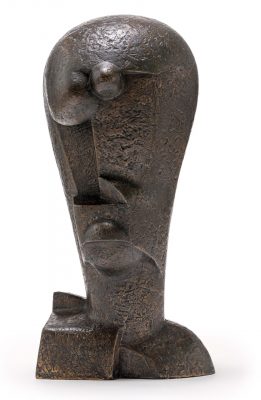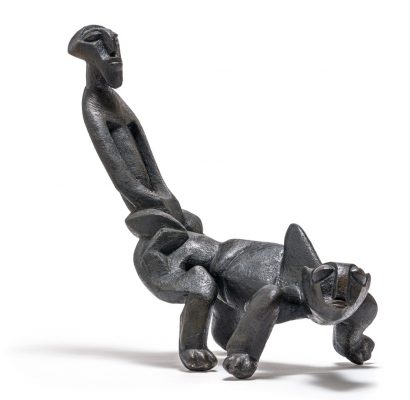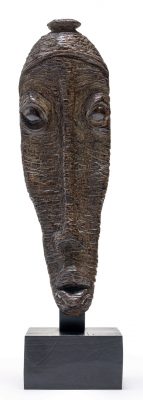A celebration of African modernism
The third session, on Monday evening (November 8), also focuses on the impact of historic African art and European modernist painting on post-war South African art. Richly illustrated and contextualized in the printed catalog, this in-session focus features paintings and sculptures by, among others, Eduardo Villa, Sydney Kumalo, Alexis Preller, Lucas Sithole, Cyprian Shilakoe and Cecil Skotnes.

“The spirit of the ancestors”
Villa, Skotnes and Kumalo exhibited together under the name Groupe Amadlozi, a term meaning “spirit of ancestors,†a name conceived by Kumalo.
German goldsmith and art dealer Egon Guenther organized their first exhibition in his Johannesburg gallery in October 1963.
Guenther, who believed that a significant work of art should reflect its time and environment, helped encourage these artists to tap into African inspiration for their work.
He exhibited them at his own vast collection of historic African art at a time when the cultural restrictions of the apartheid era made access to these types of art difficult.
Guenther also briefed Skotnes on contemporary German graphic artists, who were to have a decisive influence on his early woodcuts.
The work of Villa, Skotnes and Kumalo united the dramatic forms of the African environment and the symbolism of indigenous cosmology with currents of European modernism. They were inspired by Pablo Picasso, sculptor Constantin Brancusi, and German expressionists who had pioneered the incorporation of African themes and stylistic elements into their own art.
As a young artist, Kumalo worked with Villa twice a week from 1958 to 1960. The artists discussed the Cubist approach to simplifying the three-dimensional form, and this is evident in the structural treatment of the human form by Kumalo. He always recognized Skotnes and Villa as mentors and friends and that under their guidance he had acquired the technical skills necessary to develop his own distinctive formal language.
by Kumalo Mythological Horseman (estimate R1000,000 – 1,500,000) and hugging naked (R 180,000 – 240,000) exhibit many of the characteristics of African art and European modernism with which his fellow artists grappled.
In Mythological Horseman, a large human figure is represented astride a prowling beast. The power relations are obvious – the number is disproportionately larger than the comparatively small beast. The characters also share limbs, which simplifies the composition and complicates assumptions about the relationship between the two beings. Mythological Horseman has the same ridged, scarred surface quality as most of Kumalo’s other bronze sculptures. The depth and curves of the beast’s shape additionally create a sense of movement, and the far back pulling rider adds an additional sense of dynamism to the composition.
The exchange of ideas and practices within the Amadlozi group has undoubtedly been the catalyst for the development of the African-inspired style, content and technique of this extraordinary group of pioneering artists.


African masks
Other auction highlights that refer to African shapes are Villa’s African Mask I and II (estimate R300,000 – R500,000 and R400,000 – R600,000, respectively) and the African sculpture of Sithole Mask shape (estimate 400,000 – 600,000).
“Traditional masks play an important role in indigenous African rituals and ceremonies. They represent the spirits of animals, ancestors and mythological creatures or other natural subjects. They are used in performances and spiritual dances. Sithole and Villa were both inspired by traditional African masks and these cultural associations, â€explains Richard Ndimande, artist and art specialist at the Strauss & Co office in Johannesburg.
“The villa masks, cast in bronze, are clearly influenced by the 19th century and the beginning of the 20the Masks from West and Central Africa of the century. A key feature of these masks is the so-called double faces. In Western art, it refers to the Roman god Janus, god of beginnings, transitions and duality. In African belief systems, they are usually referred to as ‘twins’, â€says Ndimande.
The two-sided heads of Villa are reminiscent of Luba heads from the Democratic Republic of the Congo. They “often rely on dramatically simplified features and faceted surfaces that intersect at oblique angles and ricochet across the room,” explains artist Karel Nel in Bronze Villa.1
Another sculpture of Sithole, The Bison (left view), Lion Making a Kill (right view), LS8913 (estimate 300,000 – R 500,000) is a mutilated and textured composition of root mass found that the artist has chosen for his zoomorphic associations. The piece is a prime example of how African sculptors often draw inspiration from the shape of the medium itself and let themselves be guided to the final appearance.
The highlight of the auction is undoubtedly the great oil of Alexis Preller Adam and eve (estimate R7.6 – 8 million), says Alastair Meredith, Senior Art Specialist and Head of the Art Department at Strauss & Co.
“Adam and Eve is one of Preller’s mid-career masterpieces. Monumental and lyrical, rich and beautifully colored, timeless yet breathtaking, unique, loaded with symbols and gleefully complex, the painting is a beautiful snapshot of Preller’s very personal vision of Africa.
Strauss & Co’s next live virtual sale is currently open in its dedicated exhibition space at 89 Central Street, Houghton. Covid-19 regulations apply. The Johannesburg Auction Week will start at 10:00 a.m. on Sunday, November 7, and end at 7:00 p.m. on Tuesday, November 9, 2021.
See the auction at https://www.straussart.co.za/auctions/details/7-nov-2021
Remarks
Chris de Klerk and Gerhard de Kamper (2012) Villa in Bronze, Pretoria: University of Pretoria Museum, another case of the edition illustrated in color on page 50.
Strauss & Co (2010) Artists passionate about Africa: written by Emma Bedford after an interview with Egon Guenther on March 26, 2010. (https://www.straussart.co.za/2010/artists-with-a-passion -for-Africa).
Strauss & Co Auction Catalog: Live Virtual Auction, November 7 – 8, 2021 African art and ancient modernism 59-68.